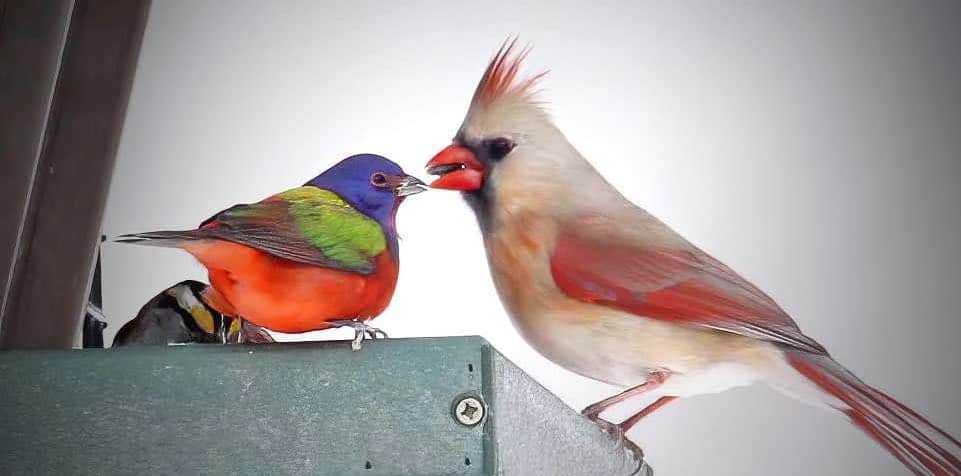
So you want to know how to attract birds to your yard? You’ve come to the right place! OnTheFeeder.com is all about backyard birding and it starts with attracting birds to your yard. Consider this your ultimate guide to attracting birds.
Inside I promise to share my best tips and secrets to attract birds by making your yard so irresistible they can’t help but visit. Better yet – they’ll move in and stay a while!
How to Attract Birds: The Basics
One of the things I love about backyard birding is it’s so easy to get started. To easily attract wild birds simply offer them bird food, have water available, and protect them by keeping your cat inside.
Attract Birds by Offering Bird Food
There’s a seemingly endless selection of wild bird food available today. Below are the basic types of bird food you can buy:
- Birdseed
- Grains
- Nuts (peanuts, acorns, almonds, pecans, etc)
- Suet (suet cakes, suet dough, pure suet).
Birdseed
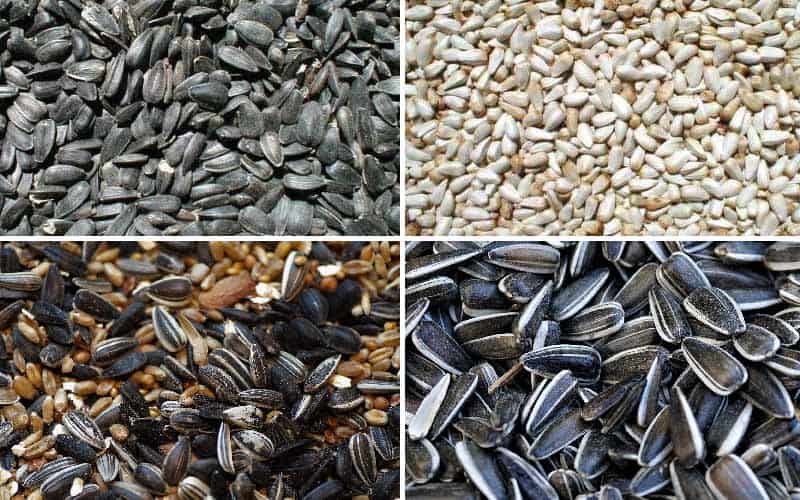
The most common types of birdseed include sunflower, black-oil sunflower, striped sunflower, safflower, and thistle.
Grains
In the wild, birds also snack on grains such as corn, milo, millet, and oats. Corn is generally sold as cracked corn. Milo, millet, and oats are typically mixed in with other birdseed and sold as a mix.
Nuts
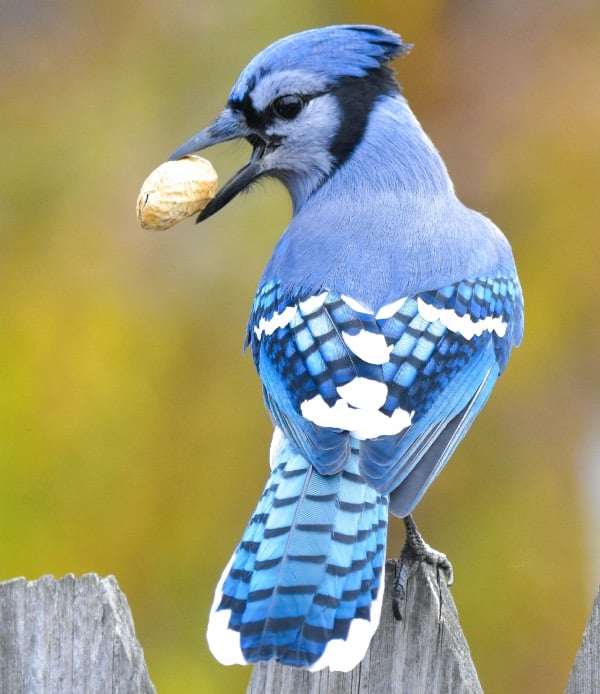
Many birds love nuts. The type of nut varies from species to species but most love peanuts. Peanuts are also the most affordable and widely available type of nut.
Peanuts can be offered in the shell or out of the shell, also known as “shelled”. Blue Jays love peanuts in the shell while woodpeckers, nuthatches, and a huge array of other species prefer shelled nuts.
Other types of nuts birds will eat and that you’ll find in birdseed mixes include acorns, almonds, pecans, beechnut, and macadamia nuts.
Regardless of the type of nut you offer, they should be as natural as possible. Unsalted, unroasted, and untreated in any way.
Suet
Suet is defined as the fat around the kidneys and loins in beef and mutton. Birds love to eat pure suet. You can get pure suet from a butcher. Technically, suet is the part they throw away but for some reason, I’ve not had much luck finding a butcher willing to let me have or even buy it. But, I keep trying.
Nowadays there are plenty of manufacturers who combine suet with other bird food (seeds, corn, nuts, etc), compress it into a square block, and call it suet cake. Kaytee, C&S, Suet Plus, and Nature’s Song are popular brands of suet cake.
Bird Feeders
There are a dizzying array of bird feeders on the market today. Some are decorative, some are functional, and others are somewhere in between. However, there are just a few types of feeders. They are the platform, hopper, tube, and suet feeders
Platform Feeder
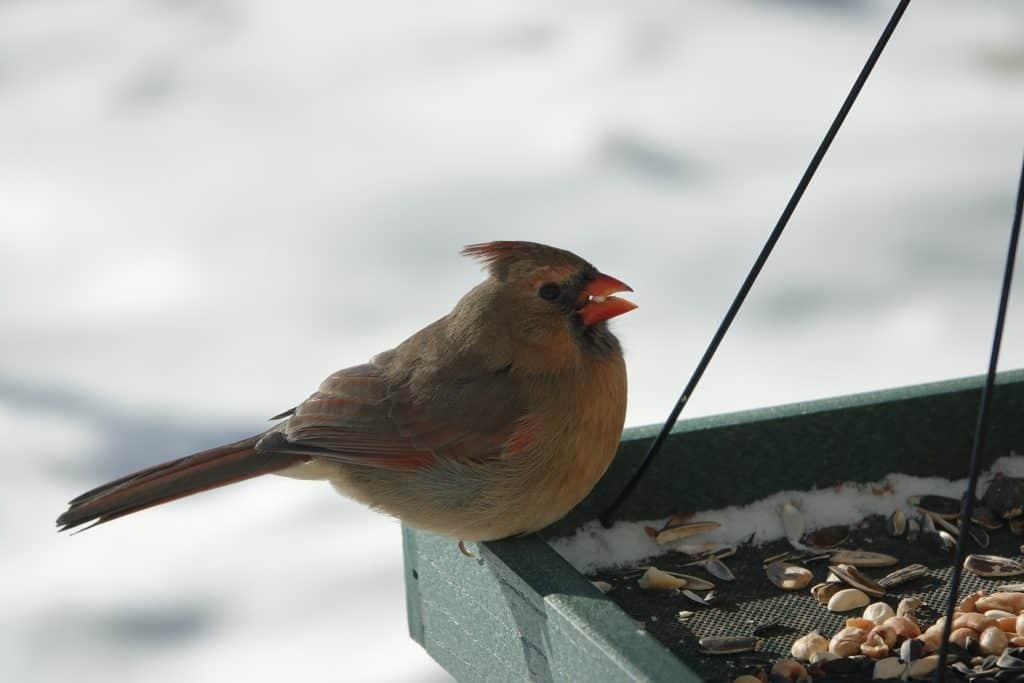
The platform feeder is by far my favorite type of feeder. It accommodates any bird food you could possibly offer. I simply grab a handful of birdseed, nuts, grains, or even chopped suet cakes and toss them onto the feeder. Voila!
Platform feeders are also suitable for many different sizes of birds – even cardinals and Blue Jays.
I love the platform feeder made from recycled plastic because it’s very easy to clean and can take being soaked in a 1:9 bleach/water solution very well.
Platform feeders are generally hung from the hook of a bird feeder pole or a simple shepherd’s hook planted in the ground. If you have squirrels in the area, definitely opt for a bird feeder pole.
The only drawback to this type of feeder is that it’s not enclosed. This means wet weather can affect the food which may cause you to prematurely throw it away and replace it with fresh food. To mitigate this, just toss a couple of days’ worth of food at a time.
Platform feeders come with a hanger to hang from a bird feeder pole, shepherd’s hook, or tree branch.
Hopper Feeder
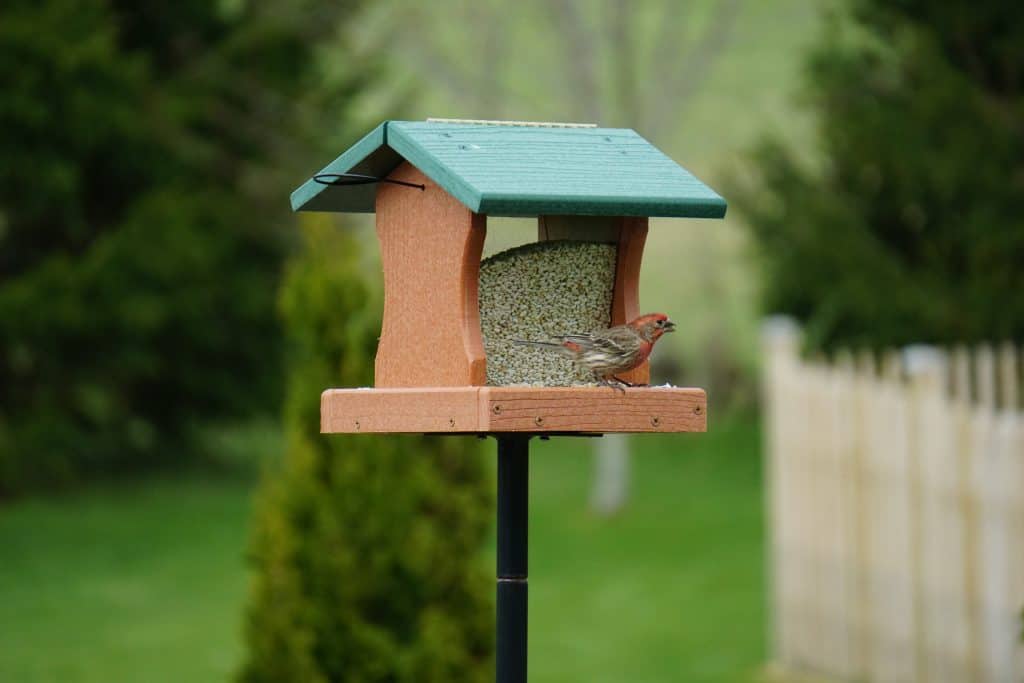
The hopper feeder features an enclosed area with the bottom open just enough to allow birdseed to trickle out. As the birds consume the food, gravity pulls more food out.
This type of feeder attracts birds because it keeps the food relatively dry (except for the seed that’s outside the container). The top opens to easily refill the food.
Hopper feeders are a good option but remember you can only fill it with birdseed and grains. Nuts are somewhat iffy as they could get stuck.
Hopper feeders usually come with 2 different mount options – top mount or hanging. The top mount enables you to install the feeder on the top of a pole. Otherwise, you can hang it from a bird feeder pole, shepherd’s hook, or tree branch
Tube Feeder
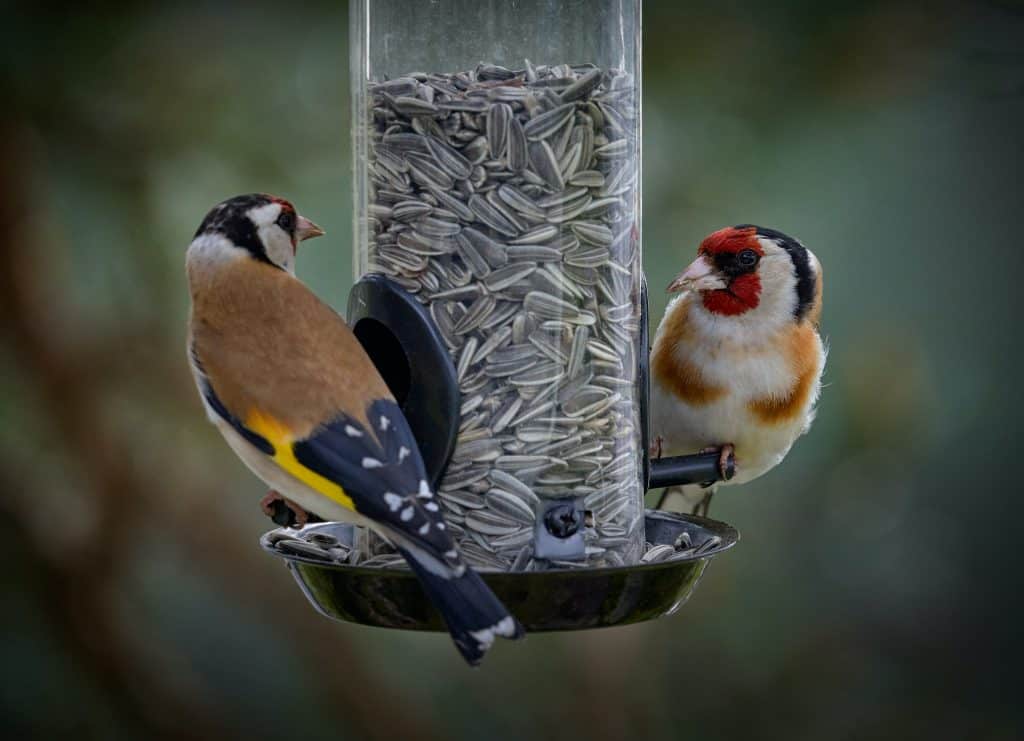
Tube feeder feeders are probably the most popular style of feeder. They’re long with a narrow cylinder that contains the birdseed. There are intermittent perching sticks and holes where the bird perches and dines on the seed.
Smaller birds like finches love this style of feeder because the perch distance is ideal for their body size. On the other hand, medium-sized and larger birds find the perch distance too short to perch and feed comfortably.
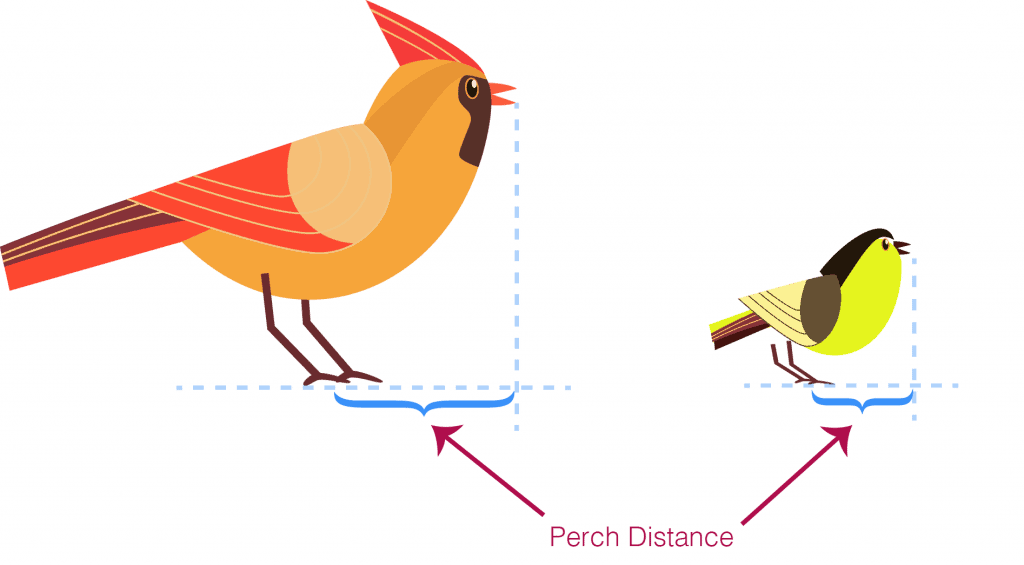
Tube feeders either accommodate sunflower and safflower seeds or thistle, but rarely do they hold both. This is because the hole that allows the seed to release to the bird is sized to the birdseed. A larger hold for sunflower and safflower seeds. A tiny hole for thistle seeds. If you want to offer both seed sizes you’ll need two tube feeders.
Tube feeders generally have a hanger at the top that you use to hang from a bird feeder pole, shepherd’s hook, or tree branch
Tube feeders usually disassemble making them easy to clean.
Suet Feeder

Suet cakes are placed in suet cages so you can hang them outside for the birds to find. While many bird species love suet, woodpeckers and nuthatches are particularly drawn to them. The cage design was likely developed with these birds in mind as they prefer to cling to the cage while drilling at the suet.
Suet cages come with little hangers so you can hang them from a bird feeder pole, shepherd’s hook, or tree branch.
Remember the platform feeder? Technically you could place the suet cake on the platform feeder. I like to chop suet and toss it onto the platform feeder because my cardinals love it!
Thistle Feeder
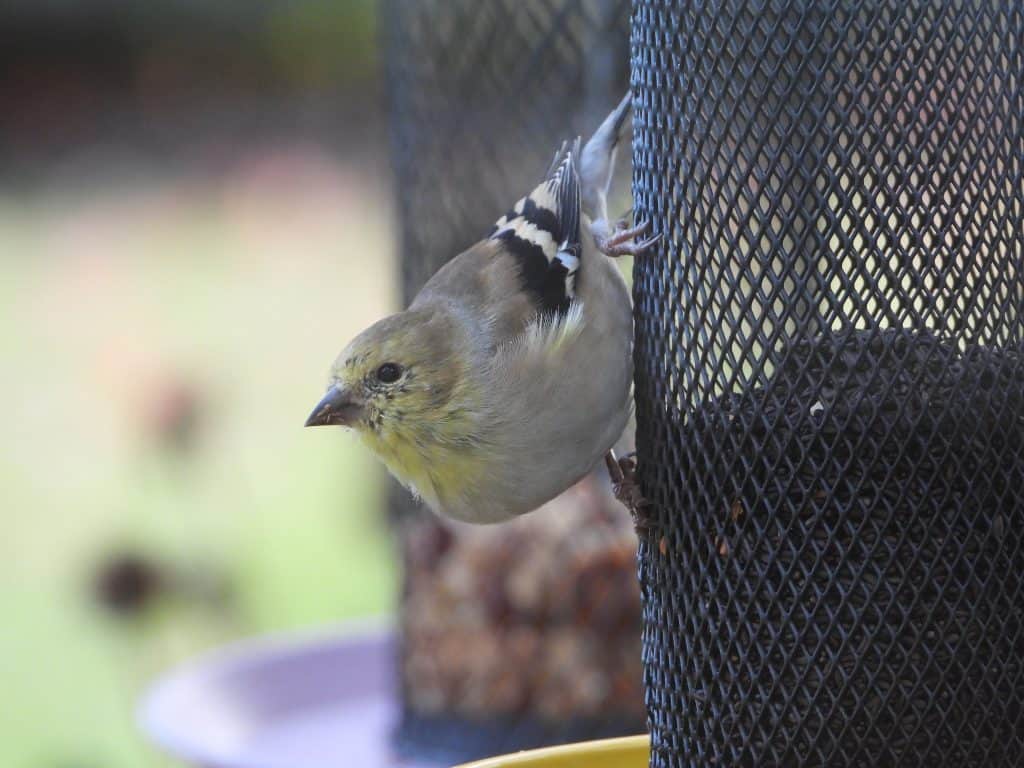
The thistle can be placed in a tube feeder as mentioned above. The only difference is that a thistle feeder only holds thistle seed and the enclosure is a mesh material that allows the birds to cling while snacking. Many birds that love thistles are accustomed to feeding by clinging.
Peanut Feeder
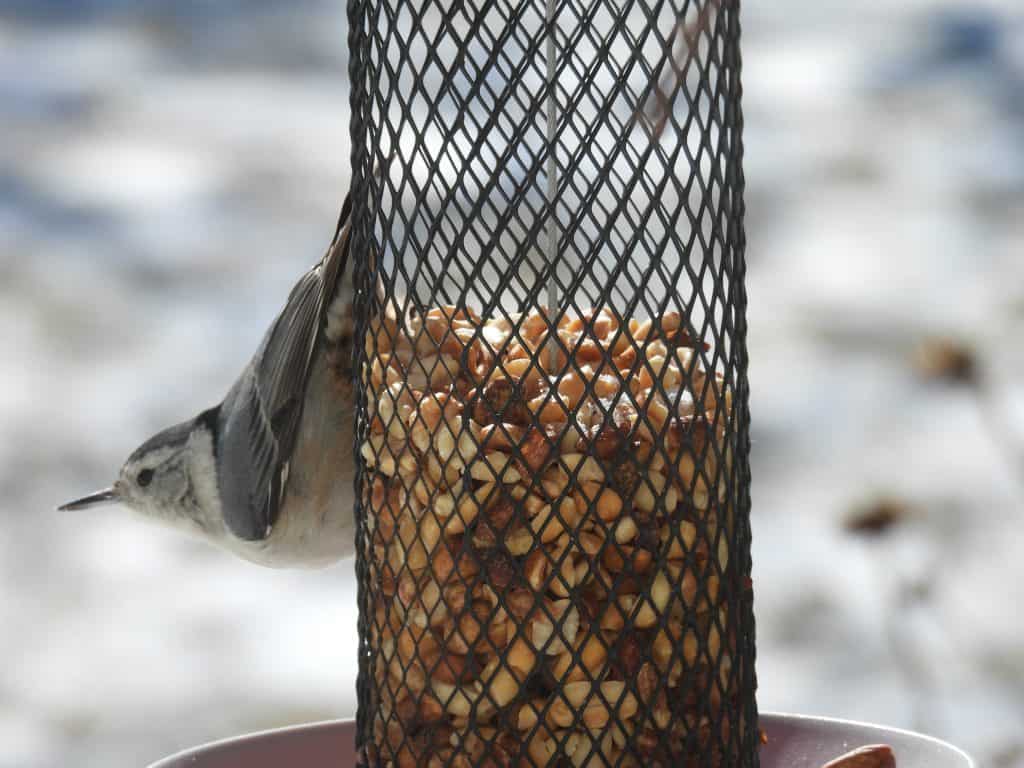
When offering peanuts (out of the shell) you can place them in a nut feeder. Many birds that love peanuts also feed by clinging to the side of a tree. This type of feeder enables them to cling while feeding.
Buying Bird Food
Bird seed, grains, and nuts are typically sold in bags ranging from 1/2 pound to 40 pounds or more. You can find them packaged by themselves (a bag of black-oil sunflower seed) or as a mix (a bag of Cardinal blend includes black-oil sunflower seed, safflower seed, and nuts).
You can buy bird food at just about any type of store – discount, department, hardware, pet, big box, grocery, and of course wild bird stores. There are online stores as well such as Amazon, Chewy, and Walmart.
Attract Birds by Having Water Available
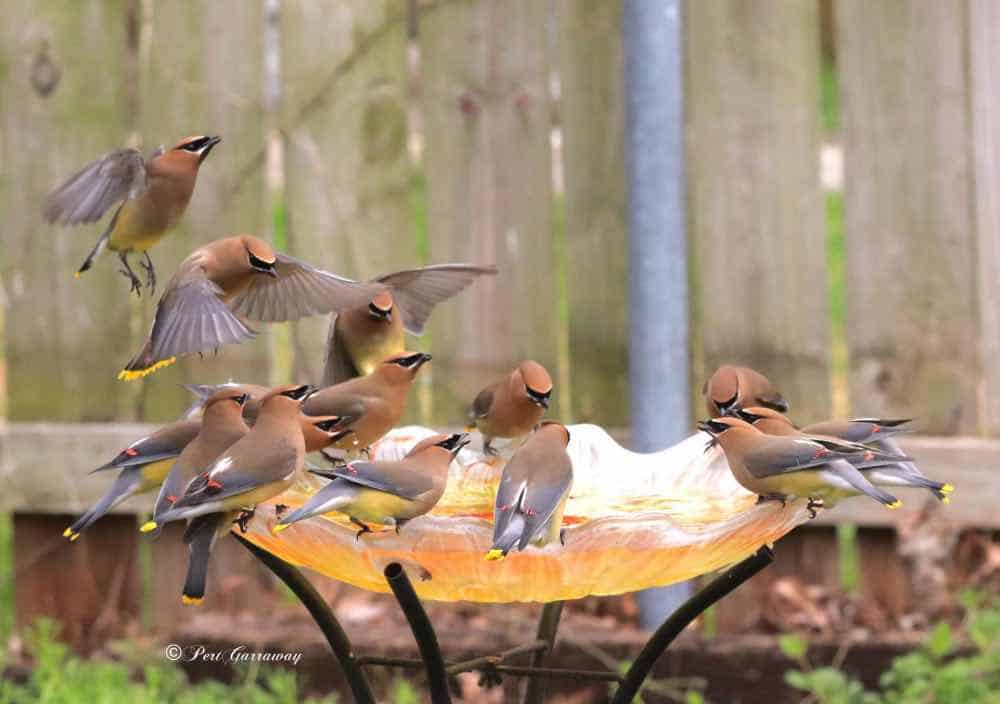
All birds need water to drink and to bathe in. By offering water you are also inviting a wider variety of bird species. This is because some birds will not visit feeders but all birds need water!
The easiest way to offer water is with a birdbath. Birdbaths can be made of concrete, plastic, glass, or metal. The material doesn’t matter as long as it’s easy to clean properly.
Place the birdbath near a shrub or tree that enables the birds to quickly escape if a predator approaches.
Placing the birdbath in a shady spot in summer is also a good idea to limit evaporation.
Offering water year-round is important, especially in winter when natural forms are frozen.
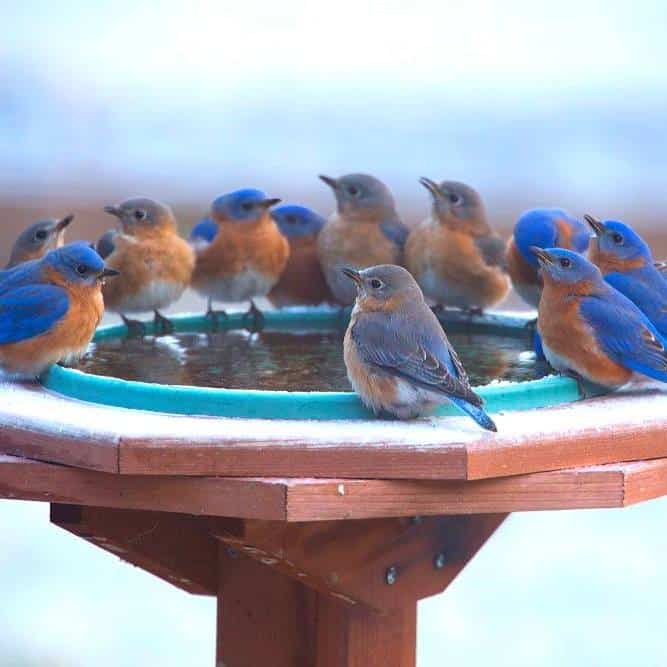
You can easily provide water to the birds in winter with a heated birdbath. Heated birdbaths include a basin for the water and a heating element that when plugged in, prevents the water from freezing.
Whether you offer a birdbath in summer or a heated one in winter, be sure to properly maintain them. This means dumping out and refreshing the water every few days and giving them a deep clean every 2 weeks.
Properly cleaning birdbaths requires a 10-minute soaking in a 1:9 bleach: water solution to kill germs that could cause disease to spread. (i.e. 1/4 cup bleach + 2.25 cups water = 1:9 solution)
Attract Birds by Keeping Domestic Cats Inside
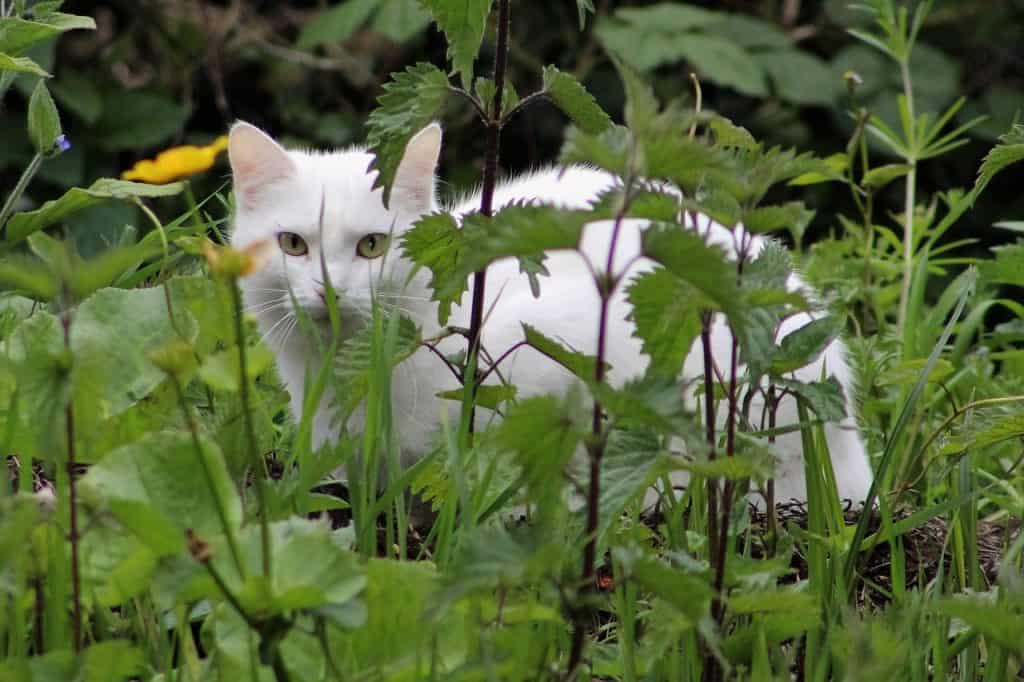
According to a study published in Nature Communications, each year almost 4 billion wild birds lose their lives to outdoor cats. That’s B as in BILLIONS. That is a lot of birds!
This is a problem because not only does this rock the ecology, it makes your yard unappealing and dangerous for birds. Eventually, the local birds will figure out your yard is not to be trusted and they’ll go down the block instead.
So, what can you do?
If you have a cat, keep it inside. I know Fluffy is adorable and innocent looking but don’t be fooled. She may be a domestic cat but still has natural instincts to hunt wild birds. It’s not her fault.
If your neighborhood has feral cats try to discourage them from hanging around by scattering fresh orange or lemon peels in the area. Better yet, consider trapping the feral feline and taking it to a human society that offers free neutering/spaying. This may prevent the next person from having to deal with a feral cat at their feeder.
What about bells? Do they help keep wild birds safe?
A New Zealand study revealed a 41% reduction in wild birds killed by domestic cats when they wore bells around their necks. While 41% is better than zero, we can still do better.
If you invite wild birds into your yard you have a responsibility to keep them as safe as possible. That means keeping the kitty inside.
How to Attract Birds: Advanced Techniques
Once you start attracting birds to your yard you can’t help but want more and different birds. While house finches and Blue Jays are amazing, you want to experience the beauty of woodpeckers and their empirical colors.
Maybe you discover a bird’s nest in your yard and one day witness the miracle of a baby bird hatching. A few weeks later that hatchling leaves the nest and you’re hooked.
Now you’re ready to attract birds at an advanced level.
In this section, I’ll share additional techniques and what you can expect by implementing them in your yard.
Attract Birds by Installing a Birdhouse
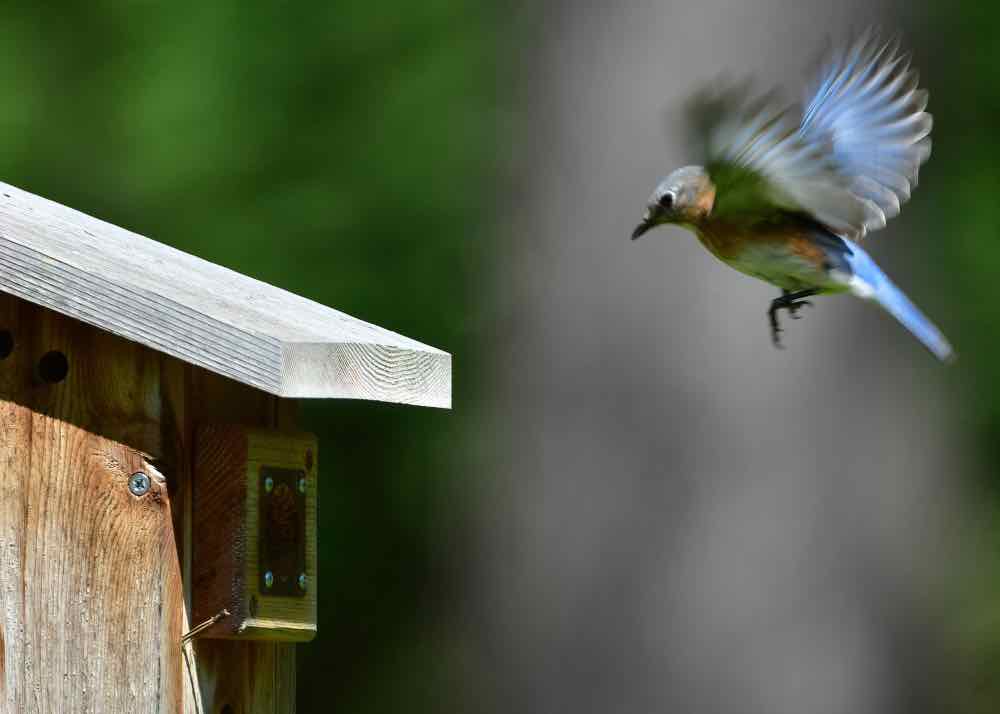
Many backyard birds build their nest in a tree or shrub while others will only nest in a cavity. In nature, a cavity is a hole or opening in wood – usually a tree but sometimes a wood post or even a telephone pole. The cavity is created by the wood rotting away, broken, or excavated by another bird such as a woodpecker.
There are more cavity-nesting birds than there are natural cavities to go around. The result is fierce competition among cavity nesters. By installing a birdhouse (also referred to as a nesting box) in your yard you’re not only bringing birds closer for your own enjoyment but also doing a service to the birds by expanding the number of cavities to nest in.
This is especially true for native birds (e.g. eastern bluebirds) that have historically had to fight off fiercely aggressive non-natives (e.g. house sparrows) for cavity space.
Over the years, ornithologists have studied the behaviors of cavity-nesting birds and identified patterns and preferences of certain species. Reputable birdhouse builders understand and know the proper sizes for each species.
Additional requirements of every birdhouse regardless of the species include:
- Ventilation for when summers get steamy hot.
- A secure roof so the inside remains dry even when it rains or snows in late spring.
- Has an escape ladder for babies to get a foothold and climb out of the box when it’s time to fledge.
- A trap door to monitor the birdhouse ensuring the contents inside are okay and to remove the old nests after the last baby fledges.
Backyard Birds That Will use a Birdhouse
Below is a list of common backyard birds that are cavity nesters and known to use a manmade birdhouse.
- Eastern Bluebird
- House Wren
- Carolina Wren
- Black-Capped Chickadee
- Carolina Chickadee
- Tufted Titmouse
- White-Breasted Nuthatch
- House Finch
- Tree Swallow
- Downy Woodpecker
- Hairy Woodpecker
- Red-Headed Woodpecker
- Northern Flicker
When winter rolls around your birdhouse will provide much-needed shelter for many birds in your yard. months
Leave the Dead & Dying Trees
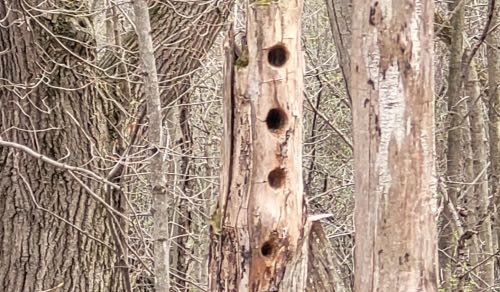
In addition to or instead of putting up birdhouses, consider leaving the dead and dying trees in your yard.
Standing trees with holes excavated and abandoned by woodpeckers are ideal for bluebirds and other cavity nesters to nest in.
Woodpeckers also love dead trees for excavating new cavities. They’re also a hiding place for insects which woodpeckers and nuthatches are keenly aware of.
If you’re serious about luring in woodpeckers and cavity nesters, resist the urge to knock down and haul away these trees.
Attract Birds by Offering Mealworms
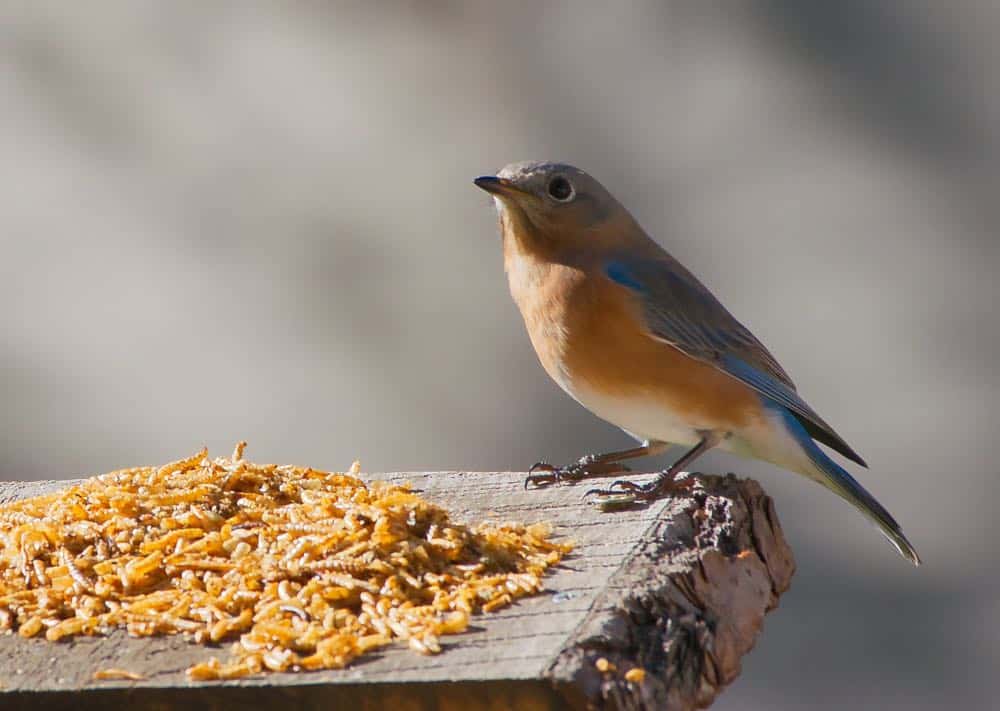
Nearly all birds eat insects (except for the strict frugivores like cedar waxwings) so you can further entice them to your yard by offering mealworms. They’re actually the larvae of mealworms but are generally called mealworms.
Mealworms are a favorite of many species including the following common backyard birds:
- American Robin
- Black-capped Chickadee
- Blue Jay
- Boreal Chickadee
- Brown-headed Nuthatch
- Bushtit
- Carolina Chickadee
- Carolina Wren
- Downy Woodpecker
- Eastern Bluebird
- Gray Jay
- Hairy Woodpecker
- Northern Mockingbird
- Pine Warbler
- Red-bellied Woodpecker
- Red-breasted Nuthatch
- Tufted Titmouse
- White-breasted Nuthatch
- Yellow-bellied Sapsucker
In the springtime, birds are particularly interested in mealworms because insects are the primary diet for their young.
Attract Birds by Offering Fruit
Many of the most vibrant colored birds are also frugivores. They’re fruit eaters. You can attract more species of birds by offering them fruit.
- Grapes will attract orioles, Steller’s jays, and American robins.
- Apples will attract varied thrush as well as American robins.
- Oranges will attract birds like orioles, tanagers, towhees, waxwings, and woodpeckers.
- Bananas will draw in bluebirds, American robins, and thrushes.
- Blueberries will delight waxwings, bluebirds, and American robins.
- Pears interest bluebirds, American robins, jays, and crows.
- Raisins attract waxwings, bluebirds, blackbirds, and mockingbirds.
The easiest way to offer fruit is to toss it onto a platform feeder. They also make fruit feeders which are essentially a hook to hang them and metal parts to poke the fruit and hold them.
Fruit also has a habit of attracting fruit flies and other insects. We already know birds love insects so this is a side benefit of putting out fruit.
Attract Birds by Going Organic
You can make your yard immensely more attractive to birds by keeping insects alive. Since most wild birds eat insects as their primary food course, consider not using grass fertilizer and pesticides. These chemicals kill the insects making your yard less appealing.
Attract Birds by Planting Native
Outside of summer when insects are plentiful, many birds rely on trees, shrubs, and fines for fruit, berries, nuts, and seeds.
Trees and shrubs also provide protection from predators such as hawks.
Native plants are particularly ideal because they don’t require special treatment to thrive and produce fruit and nuts. Non-native plants often require toxic fertilizers and pesticides which we already know kill bird-loving insects.
Below are excellent native plants that will attract birds to your yard. Be sure to know whether the flora will thrive in your climate before purchasing and planting it.
Trees
- American Holly
- Black Cherry
- Cascara Buckthorn
- Mountain Ash
- Dogwood – Silky, Flowering, Gray, Red Osier, Alt. Leaf
- Pin Cherry
- Red Mulberry
- White Mulberry
- Serviceberry
- Flowering Dogwood
- Hackberry
- Hawthorns
- Madrone
- Mountain Ash
- Red Cedar
- Sour Gum
- Eastern Red Cedar
- Spruces
- Evergreens
- Pines
Shrubs
- Blackberry
- Raspberry
- Chokeberry
- Chokecherry
- Dogwood shrubs
- Elderberry
- Shadbush
- Snowberry
- Viburnums
- Bayberry
- Blackhaw
- Cotoneaster
- Highbush Cranberry
- Holly
- Mistletoe
- Sumac
- Highbush blueberry
- Nannyberry
- Winterberry
Vines
- Grape
- Greenbriar
- Pyracantha
- Virginia Creeper
Attract Birds by Providing Nesting Materials
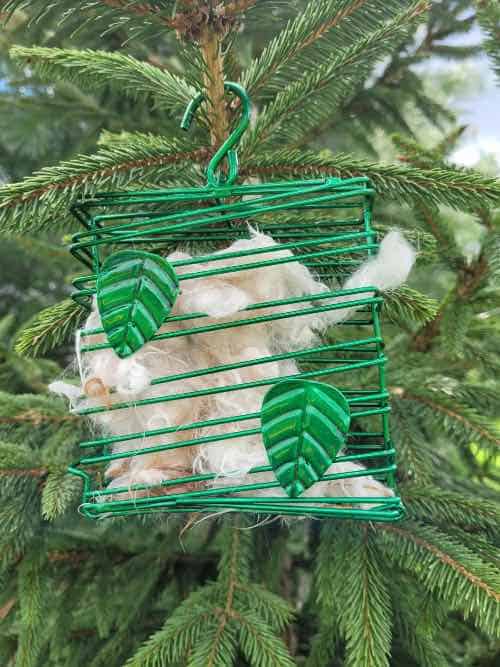
You can attract birds by making nesting easier for them. By providing nesting materials they can spend less time seeking it out and more time building the nest.
Pet fur is ideal as well as short pieces of string remnants. Trying to put them in an empty suet cage and hanging for them to find.
Caution: Never provide human hair as birds can get tangled in it.
Attract Birds Without a Feeder
There’s no denying the fact that hanging a bird feeder makes attracting birds so much easier and faster. However, not everyone is keen on hanging a bird feeder in their yard.
I’ve heard several reasons for this such as they don’t want to attract mice, rats, or bears. Others are concerned about an unsightly pile of birdseed on the ground. While there are workarounds for many of the concerns about having a bird feeder in the yard, I still respect the decision.
That’s why I’d like to highlight several ways to make your yard irresistible to birds without a bird feeder. Spoiler Alert: We already discussed them!
- Have water available
- Put up a birdhouse
- Plant Native
- Go organic
- Leave dead & dying trees
- Keep the cat inside
- Offer mealworms
How to Attract Certain Species of Birds
Now for the really fun backyard birding techniques. Making your yard totally irresistible for certain species of birds!
The Species’ Range Must Include your Yard
Before you even think about enticing the species you’re interested in, make sure this important precondition has been met: Your yard is within the bird’s range.
For example, if I lived in Oregon and wanted to attract northern cardinals I do not pass the precondition. Per the northern cardinal’s range map below, the cardinals’ range does not include Oregon.
If I lived in Wisconsin, I’m golden! The cardinals’ range includes Wisconsin so I definitely have a chance of attracting cardinals to my yard.
Northern Cardinal Range Map
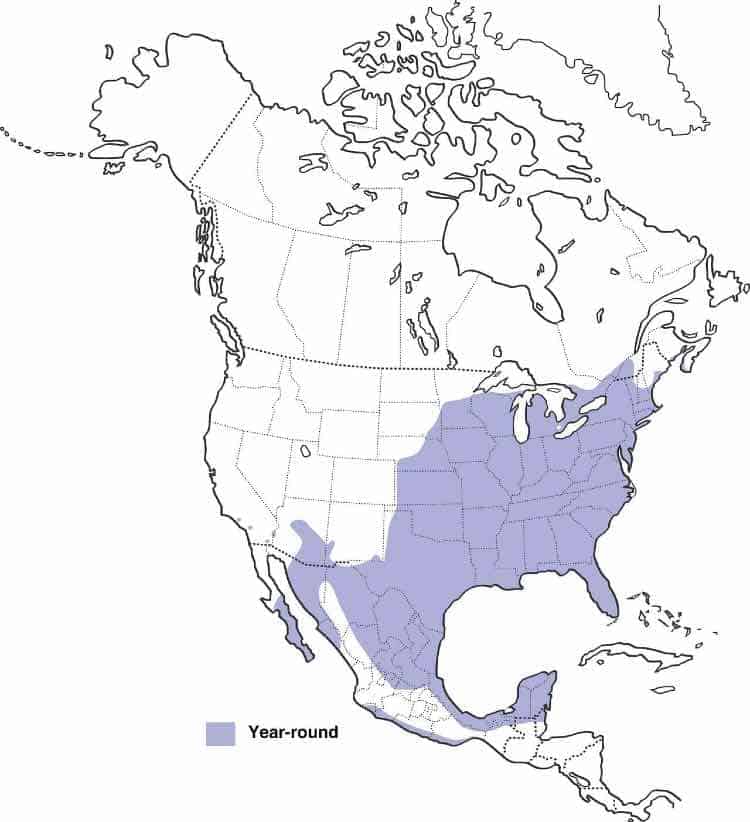
Your Yard must have What That Species Needs
In most cases, to attract certain species of birds you need to offer something the bird needs such as food, water, shelter, and nesting support.
If your yard doesn’t already offer it, you can take steps to modify the area so it becomes appealing to them.
While all bird species need water and shelter, the type of food they eat and nesting support can vary.
For example, if I wanted to attract cedar waxwings but don’t have any fruit-bearing plants in my yard, it would behoove me to plant some berry bushes or trees.
To follow are common backyard birds you may want to attract into your yard along with a link to more detailed and unique techniques for luring that species. Enjoy!
Attract Black-Capped Chickadees
Attract Red-Breasted Nuthatches
Conclusion
You can take basic steps to attract birds such as putting out a bird feeder and filling it with black-oil sunflower seed. Most birds love this food and will easily find it.
Or, you can get serious about attracting your favorite or an elusive species by offering the type of food they can’t resist and making small changes to your yard so it feels like their true habitat. For example, if you want more cardinals, toss safflower seeds onto a platform feeder and plant a few dogwood shrubs they can use for shelter. They can’t resist those small efforts!
Attracting birds to your yard is just the beginning. As your experience grows, so does your interest in nature. This is important because people who love nature can’t help but want to protect it. Our world needs more nature ambassadors.
Share your love of birding with your children, nieces & nephews, and grandchildren to ensure the next generation also appreciates the magic of wild birds.
Happy Birding!

